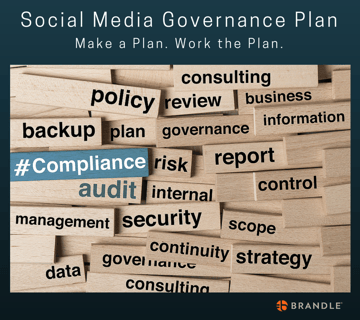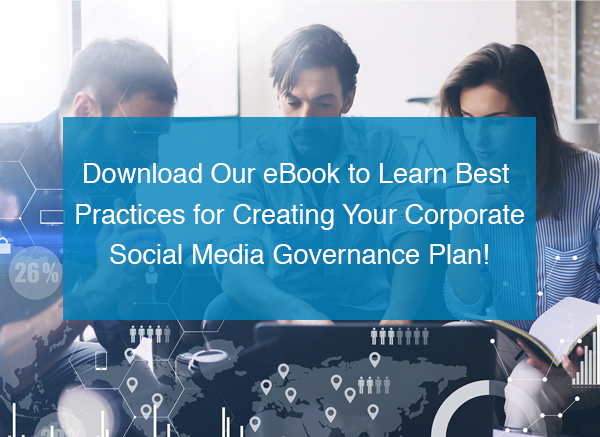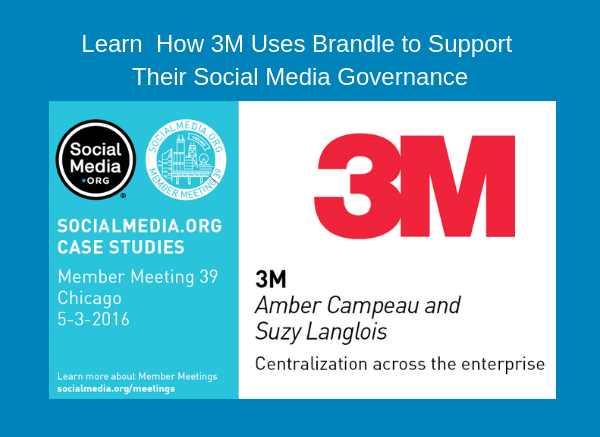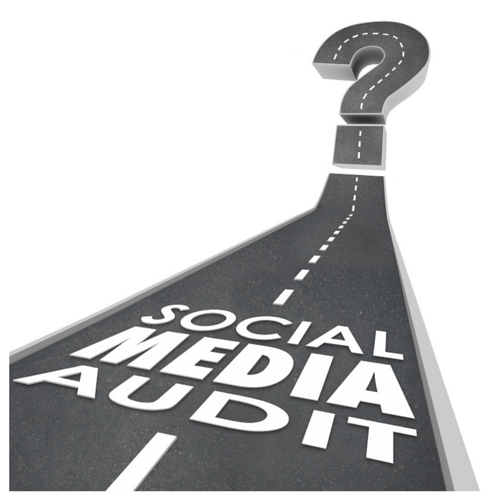 This post is the fourth and final entry of our series on how to create and manage a successful Social Media Governance Plan. At this point, you know that your key focus is to mitigate risks for your company that may arise from social media. The main risks that C-suite executives are concerned with are brand reputation damage and technology threats. (See our post on Understanding Key Corporate Risks for more details on C-Suite risk concerns.)
This post is the fourth and final entry of our series on how to create and manage a successful Social Media Governance Plan. At this point, you know that your key focus is to mitigate risks for your company that may arise from social media. The main risks that C-suite executives are concerned with are brand reputation damage and technology threats. (See our post on Understanding Key Corporate Risks for more details on C-Suite risk concerns.)
Controlling social media risks is all about creating a solid Social Media Governance Plan and maintaining an ongoing governance process. This series lays out a "best practice" outline that you can use for your company — just customize it to address specific concerns of your company and your industry.
In Part 1, Part 2, Part 3 and of this blog series, we focused on the first eight steps of your plan:
- Gather the Corporate Stakeholders of Social Media Governance, and
- Review Corporate Risk Management Priorities
- Review the Corporate Goals for Social Media Governance
- Analyze Previous Successes, Failures, and Changes
- Social Media, Employment, and Industry Law and Regulation Review
- Review Corporate Social Media Policy
- Social Network Participation and Risk Review
- Discovery — Social Media Audit Process
This is the final post in the series and we will highlight the five steps for processes and procedures of Social Media Governance.
Process & Procedures of Social Media Governance
We have covered a lot of governance ground the past six weeks! The five remaining steps to finalize your plan are:
- Social Media Governance Process
- Procedures for Risk Events
- Train Employees on Social Media Governance
- Social Media Monitoring Procedures
- Review Cycle for Social Media Governance Plan
We have listed some general ideas you need to think about for each step, but every company has to determine how to flesh-out the processes and procedures that are right for you.
Social Media Governance Process
This section is all about the ongoing processes that are needed in order to practice strong social media risk management. Creating the plan is just the first step. How will you make sure risks are managed and how will you measure that risks are being managed? Some of the elements you may develop for this section of the plan include:
Governance Team Reporting & Meetings
- How often will the core stakeholder team meet to review company risks and the team's performance managing those risks for their departments?
- What reports and format are needed in each department, for the stakeholder team, and for the executive team? What is the delivery time of each report? How are the reports maintained as part of the governance process in case of an audit (especially if you are in a regulated industry).
- What is the stakeholder team alert system in the event of a risk occurrence? (We will address more risk procedures in a section below).
Governance KPI Documentation
What are your goals for each segment of the plan and how will you measure the success of those goals? These should be KPIs (Key Performance Indicators) that help you manage the process of governance. For every example you list, be sure to ask important measurement questions: "What is our goal?", "How will this be measured?", "How can we ensure measurement is accurate"?
Here are a few examples:
- Risk response was x% faster than previous risk response.
- Governance goals for Sales, and any department that touches social media, were met in reduced/increased time frame.
- Rogue account creation from corporate employees increased/decreased.
- Employee compliance on their social accounts was x% compared to previous period of y%.
You get the idea. Think about the key corporate risk events to guide you in some of these ideas as well as each department's "hot buttons" around governance. Be sure to define executive reports from this information and make sure you include the KPIs they care about most!
Policies to Govern Social Media Accounts and Pages
In Part 2 of this series, we addressed the importance of creating different policies that are needed to guide your social employees with consistent corporate direction. However, larger organizations may need additional policies that define the process and requirements around managing social media accounts and pages. These policies are for the employees (and agencies) that are managing the corporate and brand accounts. Here are some thoughts on governance policies for the global digital team.
- Prerequisite for Creating New Account/Page on a Social Network.
- Social Presence Maintenance Policy.
- Rogue Account Take-down Process.
- Regulatory Compliance Policy.
Social Media Tools Review and Management
Corporate social media business practices cannot be accomplished without using third-party tools. These tools include the content systems for publishing, archiving, sentiment analysis, listening, audience analysis, and a presence management systems (such as Brandle). The field of Social Media Management Tools and Social Media Monitoring Tools is growing significantly every year. There is also a current trend of M&A (Mergers and Acquisitions) in this sector of SaaS tools, so an annual review of your tool set is an important management step.
Procedures For Social Media Risk Events
Now that you've identified your corporate risks and policies, it's time create some test scenarios in order to define your best procedures during a risk event. List the risk events that could potentially occur and design a perfect process (throughout each department) to ensure the event will be handled correctly. Next, run through these events as if they weren't handled very well and design an escalation protocol that has a chance of calming the event or mitigating the risk to the company.
Here are areas where risk might arise:
- Technical Risks
- Brand Risks
- Social Content Risks
- External Events. Disseminating external risk events (and how your company is handling the situation) on social media is also a good risk mitigation practice.
- Regulatory Audits
What are the key risk areas for your company and what procedures will work best to address risk events? The main goal is to provide a framework for employees to take action during a risk event and to understand the who, what, when, where and how within each department.
Train Employees on Social Media Governance
You need to document your employee training process and reference the location (on the corporate network) of the training materials in your Social Media Governance Plan. You should also document the timing of special training programs, goals to achieve a certain success rate for training (and what success means to you), and the metrics you are shooting for (such as "Increase Employee Certifications from 20% of potential brand advocates to 40%").
Training Protocol
There should be a training protocol for each type of Social Employee including:
- Social Governance Team
- Corporate Social Marketing Team
- Social Sales Team
- Social Customer Service Team
- Social Employee, Brand Advocates
- Ideation Team (if you crowd source product or service ideas).
Training Methods
There are many methods to train people on policies, regulatory requirements, and procedures. However, the most important design of your training program is how you will manage the ongoing process of training for different types of employees at different stages of learning. What training process will work for your company? The tools to train are straightforward:
- Documentation: includes written policies, procedures, ideas, and examples
- Webinars
- On-site Training
- Certification Programs
Finally, part of training your employees is being clear about how you will be monitoring the accounts they manage (whether they are corporate accounts or employee-owned accounts).
Social Media Monitoring Procedures
Every company has different goals and needs for monitoring social media. For many companies, only corporate-owned accounts are monitored. However, if you are authorizing employees to become brand advocates and allow them to use their own accounts, there should be a form of monitoring in place. The monitoring tactics should be inline with the social media policies, training, and governance that you have already put in place.
If you are in a regulated industry, there is little choice but to monitor your employees accounts as it is a requirement of doing business (especially in the financial industry). Training and monitoring take on a heightened importance for these companies.
Monitoring should include:
- The Social Media Presence — the asset (everything on the profile, the URL, the referenced websites and images).
- Compliance (regulatory, policy, training)
- Standards (brand standards, posting schedule, goals met)
- Spot checks in Content Stream for standards and compliance
If you train your employees before you start monitoring, there will probably be fewer accounts that do not meet your expectations. However, if you need to monitor employee accounts before a full training process, then this is an opportunity to not only correct an employees account but to train them as well (which is critical in a regulated business).
Review Cycle for Governance Plan
This is straightforward. How often will the plan be reviewed? Which segments of the plan need updating more frequently?
Most companies review their plan annually. If you've created a comprehensive plan, it may only be necessary to update specific segments of your plan. You should consider reviewing and making changes to your plan when you receive crucial information such as new corporate risks that need to be considered, new regulations that need to be included in training, or new experiences with risk events that can improve your processes.
Remember: the most important part of social media governance is the ongoing discipline of the practice of governance. Governance is never completed — so be sure to give yourself (and your team) kudos because you are practicing good governance and minimizing risk for your company.
Make a Plan and Work the Plan!
That concludes the series on how to develop a strong Social Media Governance Plan.
If you are looking at GRC tools or social media monitoring tools to help you with brand protection and social media security, we hope you take a look at Brandle. We make it easy for any company to audit the web, keep a centralized living inventory for a global team, and apply compliance processes.









